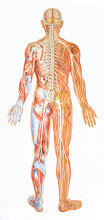ØA. Axoplasmlc(Axonal) Transport: Movement of metabolic products through the axoplasm Can be fast (up to 400 mm/d) or slow (eg, 1 mm/d), and it involves neurotubules and neurofilaments. Anterograde or Orthograde axoplasmic transport moves newly synthesized products and synaptic vesicles toward the axon's terminal arborization and can be fast or slow. Retrograde axoplasmic transport, the return of worn materials to the perikaryon for degradation or reutilization, is usually relatively fast.
ØB. Signal Generation and Transmission: The basic function of nerve tissue is to generate and transmit signals, in the form of nerve impulses or action potentials, from one part of the body to another. The arrangement of neurons in chains and circuits allows integration of simple on-off Signals into complex information. The microscopic structure of nerve tissue (axon diameter, presence or absence of myelin, etc) exploits physicochemical phenomena to regulate the rate and sequence of signal transmission.
Ø1. Resting membrane potential.
Ø2. Firing and propagation of action potentials.
Ø3. Refractory period.
Ø4. Direction of signal transmission.
Ø5. Saltatory conduction.
Ø6. Blocking signal transmission,
HISTOPHYSIOLOGY OF NERVE TISSUE
Etiketler:
nerve tissue
Subscribe to:
Posts (Atom)
